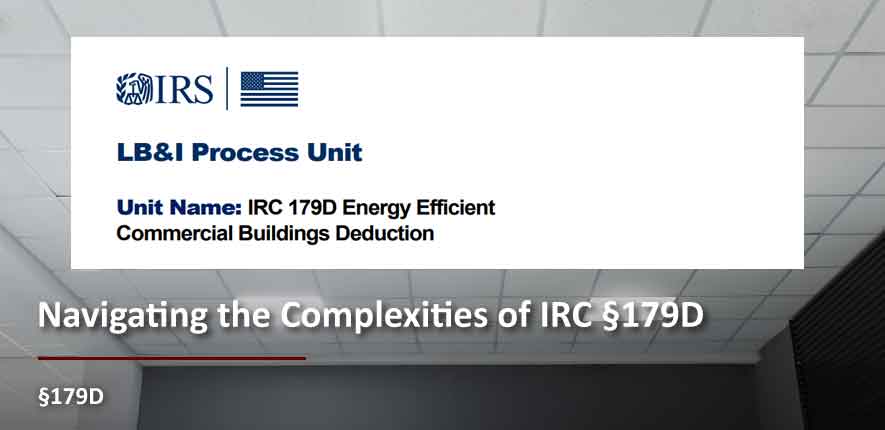
Mar 31, 2025 Navigating the Complexities of IRC §179D: Why Expert Guidance is Essential
The Internal Revenue Service (IRS) has released an updated Practice Unit on the §179D Energy Efficient Commercial Buildings Deduction. Practice Units are internal IRS training guides that help examiners understand complex tax provisions and identify compliance risks. While these units are not official guidance, they provide valuable insights into how the IRS approaches audits and enforcement related to specific tax incentives.
The latest updates to §179D, particularly those stemming from the Inflation Reduction Act (IRA) of 2022, introduce new eligibility rules, compliance requirements, and higher deduction limits. However, navigating these provisions can be highly complex, and failing to adhere to IRS guidelines could lead to audit exposure. Engaging qualified tax professionals and engineers is critical to ensuring compliance and maximizing the benefits of this deduction.
The Basics of §179D
Initially introduced under the Energy Policy Act of 2005, §179D provides tax incentives for energy-efficient improvements in commercial buildings. The deduction applies to energy-efficient commercial building property (EECBP) that enhances the performance of:
- Interior lighting systems
- Heating, ventilation, air conditioning, and hot water systems
- The building envelope
To claim the deduction, property owners and designers must comply with strict energy efficiency requirements and obtain certifications verifying their claims.
Key Updates Under the Inflation Reduction Act of 2022
The IRA introduced substantial changes to the deduction, effective for property placed in service after December 31, 2022. Key updates include:
- Expanded Eligibility:
Designers of EECBP installed in buildings owned by government or tax-exempt entities, including tribal governments and nonprofit organizations, can now claim the deduction. - Higher Deduction Limits:
Projects that meet prevailing wage and apprenticeship requirements may receive a deduction up to five times higher than before, subject to inflation adjustments.
The Complexity of Compliance and the Risk of Audit Exposure
While these changes provide lucrative opportunities, they also introduce significant compliance risks. The IRS closely scrutinizes §179D claims due to the substantial financial benefits involved. Failure to meet documentation requirements, misinterpret energy savings calculations, or incorrectly allocate deductions can trigger audits, penalties, and potential loss of deductions.
Key compliance challenges include:
- Certification Requirements:
The deduction requires certification from a qualified individual confirming that the property meets stringent energy savings thresholds. - Accurate Allocation for Designers:
When designers claim an allocated deduction from tax-exempt entities, they must provide detailed written agreements that satisfy IRS requirements. - Adhering to Prevailing Wage and Apprenticeship Standards:
To claim the enhanced deduction, taxpayers must comply with strict labor rules, which require careful record-keeping and compliance verification.
The Critical Role of Qualified Tax Professionals and Engineers
Given the complexity of these rules, working with experienced tax professionals and qualified engineers is essential. Tax advisors ensure proper compliance with IRS regulations, while engineers provide accurate energy efficiency calculations and necessary certifications. Their expertise helps Mitigate Audit Risks, Maximize Tax Benefits, and Ensure Regulatory Compliance.
Conclusion
The updated §179D Deduction offers substantial financial incentives for energy-efficient commercial buildings, but the associated rules are intricate and require meticulous adherence to IRS guidelines. The experts at ICS Tax, LLC have a dedicated team with over 15 years of experience specializing in §179D. Our deep knowledge of tax law and energy efficiency certification ensures taxpayers maximize their deductions while maintaining full compliance with IRS regulations.


